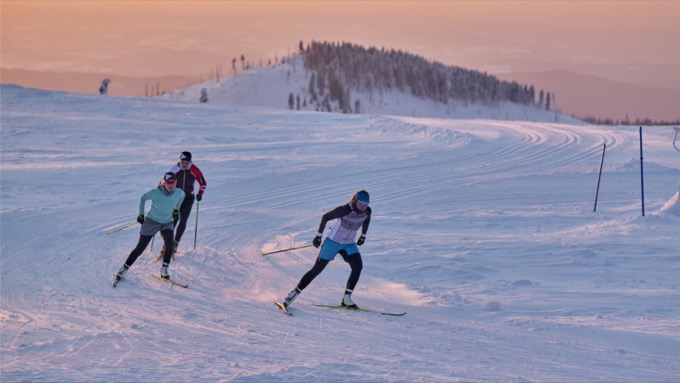
Skiing downhill on cross country skis is challenging. New skiers are intimidated and concerned. Even experienced skiers may struggle to ski the downhills to the best of their ability.
This article covers:
- The unique challenges of cross country skiing down hills.
- The various downhill cross country ski techniques for controlling or improving speed.
- Proven strategies for maximizing speed while minimizing risk on downhill turns.
Learn the range of downhill cross country ski techniques. Practice these techniques and related skills and start skiing with greater confidence and control.
Table of Contents
Ski Equipment: Alpine vs Nordic
Experienced Alpine skiers are often caught by surprise at the difficulty of Nordic downhill skiing.
Some of their skills transfer to cross country skiing, but there’s a big gap between the sports. It’s a mistake for Alpine skiers to be overly confident on cross-country skis.
Nordic ski equipment and Alpine ski equipment are built for different purposes. Yes, both are skiing sports, but that’s like saying road biking and mountain biking are similar sports.
Alpine ski equipment is specialized for skiing downhill. Nordic ski equipment has to work across a wide range of terrain, uphills, downhills and everything in between.
Lightweight and unstable
Nordic ski equipment is much less stable than Alpine equipment:
- Cross country skis, boots and binding are lightweight compared to Alpine ski equipment. Your centre of mass is higher on cross country skis.
- Cross country skis are flexed and springy. Again, your centre of mass is high.
- Alpine skis have more surface contact with the snow, increasing friction and stability.
- Classic and skate cross country skis that are specialized for skiing on groomed trails don’t have metal edges.
- Cross country ski boots attach to the ski at the toe of the boot, and are not solidly locked down like an alpine ski boot.
Did you know we instructional cross-country ski videos?
For skiers just getting started:
Help for struggling skate skiers: The One Skate Dance Drill
Cross Country Ski Trails
Nordic ski trails range from wide open, well graded trails that are groomed on a daily basis to narrow trails that wind up and down steep hills.
Easy
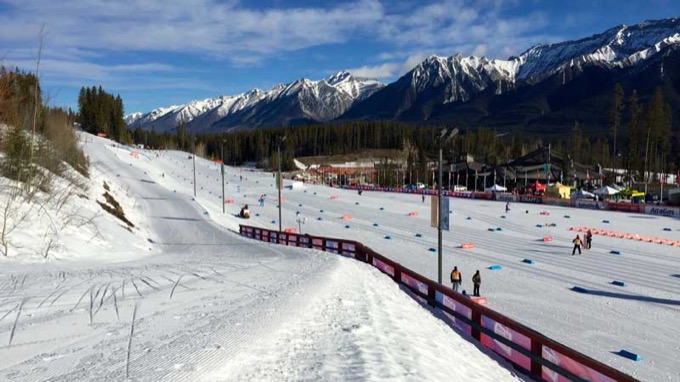
Difficult
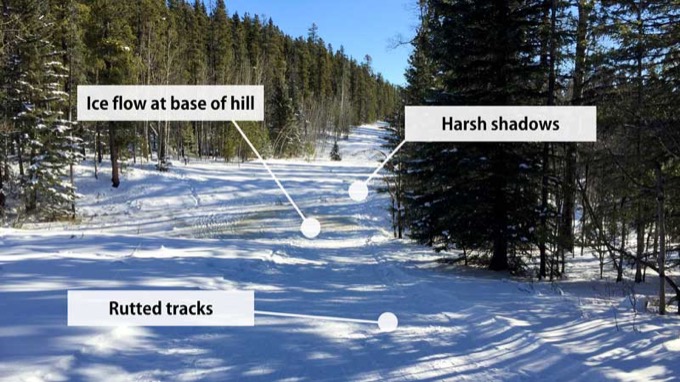
Some of the obstacles and challenges you may encounter while cross country skiing:
- Icy downhills where the snow has been plowed off by previous skiers.
- Narrow, steep downhills, with cupping in the middle of the track that gives you less edge control and little room for snowplowing.
- Blind, sharp corners.
- Rough and rutted snow that pulls your skis in different directions.
- Blowouts where previous skiers have gone off the track.
- Unexpected obstacles, such as groups of skiers stopped on the hill.
- Narrow bridges at the base of steep hills.
- Ice flows.
Nordic Downhill Ski Techniques
The 4* downhill cross country ski techniques are:
- Snowplow
- Parallel Skidding and Skid Turns
- Step Turns
- Tuck
The first 2 techniques, snowplow and parallel skidding, are braking techniques. In both these techniques, the skis are scraped against the snow to increase friction.
Both step turns and tucking are for maximizing speed. Step turns are unique to cross country skiing. Tuck is similar to tucking on downhill skis.
The 4 core techniques can be used alone or in combination, depending on what you’re trying to do.
Do you want to reduce and control your speed, or maximize your speed? Is the trail running straight or turning? These are the factors you will weigh in your decision making.
[*NOTE: I didn’t included telemarking because our focus here at Nordic Ski Lab are the performance techniques used by competitive cross-country skiers. Telemark skiing lies outside that scope.]
Skidding
Skidding is a braking maneuver used to control speed in both Alpine and Nordic skiing. Both snowplow and parallel skidding are skidding techniques.
Skidding happens whenever a ski is edged and angled across the direction of travel. The edge of the ski shaves the surface of the snow.
In skidding techniques, the skis are either set in a wedge shape, with the tips closer together than the tails (snowplow) or parallel to one another.
In Nordic skiing, skidding is both more important and more challenging than in Alpine skiing.
It’s more important because the Nordic skier has a greater need to check speed.
It’s more difficult because the equipment is lightweight and race skis don’t have metal edges.
[Note that the scraping action can wear off classic kick wax and reduce grip. If you are skiing on waxable classic skis and you snowplow a lot you may find you need to reapply your wax. ]
Snowplow
Snowplow on cross country skis is the same as snowplow on Alpine skis, except it’s more challenging because the equipment is so lightweight.
- Feet are wide and toes point a little inward.
- Skis are rolled on the inside edges.
- Skis are in a wedge shape, with the tips closer together than the tails.
- Bend into the hips, knees and ankles so your body is low.
- Hands held out in front of the body.
Refer to this video course for instructions for learning the beginner Nordic Downhill Ski Techniques (Skate or Classic Skiing).
Parallel Skids and Skid Turns
Parallel skidding refers to when the skis are parallel to each other and rolled onto their edges. Both skis are rolled onto the same edge – right or left.
The edges of the skis scrape against the snow to slow the skier’s descent.
This is the same maneuver as is done on Alpine skis, just more challenging for reasons already discussed.
Examples of parallel skidding are:
- Sideslipping down a hill,
- Skidding through a turn, and
- Skid stops, a.k.a. hockey stops.
Step Turns
The first 2 techniques we looked at – snowplow and skidding – are used to slow down and control speed.
The next 2 techniques – step turns and tucking – are for retaining or increasing speed.
The most notable difference between Nordic and Alpine downhill skiing is how downhill turns are taken at speed.
Alpine skiers carve turns. Cross country skiers use a technique called a step turn.
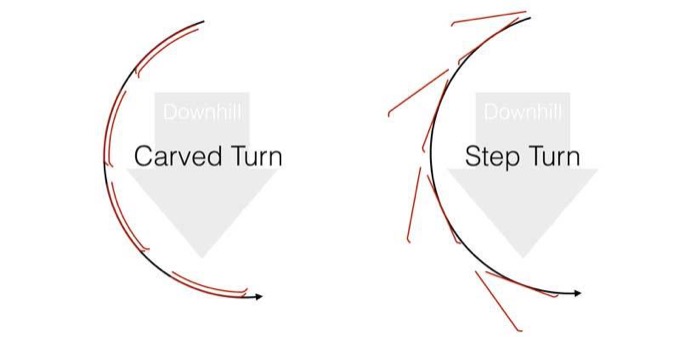
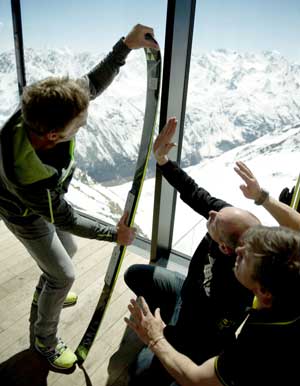
Alpine Ski Design
Alpine skis have sharp metal edges and impressive parabolic sidecuts. Parabolic side cuts are when a ski has curved sides, as if a large circle was cut out of the side of the ski.
Alpine skiers carve turns by tilting their skis onto their edges and applying pressure. That makes the parabolic side cut form an arc so the ski runs through the turn, carving a pencil-thin track in the snow.
Cross Country Ski Design
Cross country skis also have a side cut, but it’s not parabolic.
Instead of wide tips and tails and a narrow underfoot, cross country skis have more of a linear side cut, with little variation between tip, underfoot and tail.
A downhill skier can track through the arc of a turn, but a cross country skier has to use a technique called a step turn. Each step hits a tangent on the arc.
Step Turns
- The skis are in a V-shape, with the tails together and tips further apart.
- The innermost ski gets redirected around the turn with every step.
- The outermost ski may be used in a skate push action to add speed, depending on the speed of travel.
Alpine skis are rarely, if ever, positioned in a V-shape during a descent.
Tuck
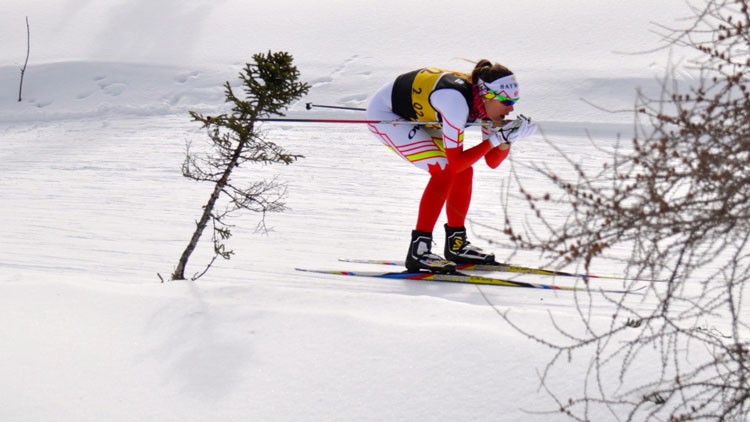
A tuck is the same simple stance as is used in Alpine downhill skiing. You can take the tuck in high or low position. A low tuck is more aerodynamic and a high tuck is less physically demanding.
Important: Pay attention to your pole tips. Hold your poles so the tips are directed downwards. Do not let your pole tips point up. That is eye level for skiers approaching you from behind.
Downhill Turns in the Classic Ski Tracks
Classic ski tracks present a special challenge on the downhills.
On machine groomed and trackset cross country ski trails, the groomers are trained to lift the trackset machine on certain downhills.
They do this for safety reasons, so the skier can easily move her skis into a snowplow, skid or step turn.
But there are times when the ski tracks are still in place but may be too dangerous to ski in. For example:
- The groomer made a mistake and left the tracks in where they shouldn’t have. Everyone makes mistakes and not all groomers are experienced.
- Conditions have changed since the trail was groomed and the snow is significantly faster.
- You aren’t “most skiers”. You are you. What is your skill level for taking a turn in the tracks?
- Someone already blew out of the tracks into the ditch. In that case your skis are likely to follow that same path and dump you off the trail.
Ultimately, it’s up to you to know whether you can safely take a turn in the tracks or whether you should step out.
If you want to step out, do it early, before you pick up too much speed.
Skiing for Safety
In addition to learning and practicing the various Nordic downhill ski techniques, the key things you can do to improve your safety and confidence on the downhills are:
- Widen your base of support
- Lower your centre of mass
- Improve your agility
Wide and Low
To improve your stability on the downhills:
- Keep your feet about shoulder width apart or slightly wider.
- Flex into your hips, knees and ankles. Flex deeper for added stability.
- Keep your weight even across the bottoms of your feet.
- Keep your hands wide and out in front of your body.
- Look where you want to go.
Agility
Build your agility on hills where you feel comfortable, like a teaching hill near the stadium.
- Quick Feet – practice picking up your feet on the downhills.
- Tracks – practice stepping in and out of the tracks on a slight downhill .(Practice on the flats first if you haven’t done this before.)
- Hard stops – practice coming to a stop as quickly as you can. Check behind you for oncoming skiers before you try this.
If you are truly terrified of the downhills or you have real trouble with balance, you should buy skis that provide greater stability. Look for wider, metal edged skis.
Skiing for Speed
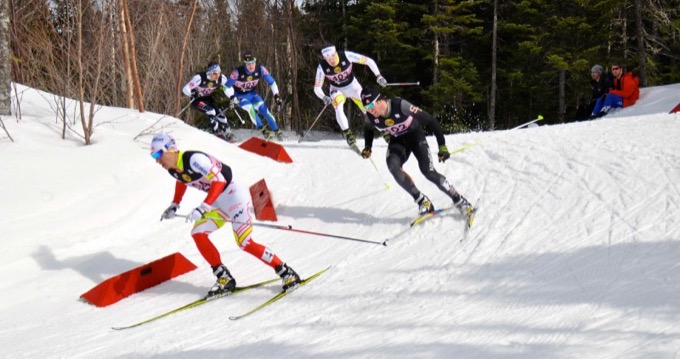
Skiing a straight run at speed is pretty straightforward. Just get into a low tuck and let ‘er rip.
Skiing downhill turns at speed requires more skill and strategy.
High exit velocity should be a your top priority. Exit speed matters more than staying tight in the corner. It’s better to take a wide turn at a higher speed than to take a tight turn at a slower speed.
Faster skiers brake rapidly at the start of the turn and then maintain speed through the turn. Slower skiers tend to brake for a longer period of time and exit the turn with a lower velocity.
So, if you’re about to enter a turn too fast and you need to skid, do it early and hard. Rapidly decelerate to a safe speed, then begin step turning as soon as possible to regain speed as you leave the turn. Build extra speed with rapid, powerful leg push offs.

